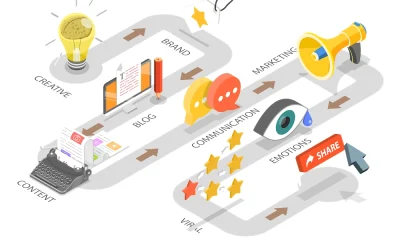Marketing
How To Optimize Content For Featured Snippets

In this business blog article, we look at featured snippets and how you can optimize the content to benefit your site and increase its traffic significantly.
The appearance of the Search engine results page, or SERP, has changed over time – Google search results have become more extensive and informative.
In addition to the standard blue links, the results now include pictures, videos, maps with marks, and alternative snippets. Featured snippets are one example, appearing at the top of the SERP and more visible than other sites.
According to research, most users click on the top search results.
- The CTR (click-through rate) of the first position is 28.5%.
- The CTR of the second position is two times lower – about 15%
Let’s dive deep into featured snippets and how to adapt your pages to them.
What Is A Featured Snippet?
A featured snippet in the search result (the so-called “zero position”) in the form of a selected block generates a ready answer to a question.
Unlike regular snippets with title, description, and URL, a featured snippet displays page fragments that can be formatted as a paragraph or list, including images. Its elements are arranged in reverse order, with the description at the top and the title at the bottom.
Among other Google SERP features, this snippet gets absolute priority on the screen – in terms of size and position and the fact that Google selects only one site for such a result. When a page is featured in a Featured snippet, its CTR and traffic will increase significantly.
How Can You Structure Content For Featured Snippets?
Your article or blog content needs to use keywords the searcher used in their query and succinctly answer their question or provide the relevant information. There are many ways to present the content that can present in a featured snippet, including:
- Bullet points
- Table
- Video
- Paragraph
Types of Featured Snippets
Do some keyword searches now, and you’ll witness featured snippet displays, including laconic, in the form of a small block with text, multiple elements – with a list and photo gallery, and others. Let’s explore the types of Featured snippets in more detail.
Paragraph
This is usually a definition or text on a page with a direct answer to a question. As a rule, snippets of this format are displayed by information requests with marker words like “what is,” “how,” “why,” “where,” and so on. They can often be compared to encyclopedic summaries containing brief, comprehensive information and illustrations – pictures, diagrams, and graphs.
Numbered or Bullet list
Another standard snippet contains an answer that is formatted as a list. In most cases, they appear when the user intends to get a selection of options to compare and choose from. Here, marker words can be “best,” ”which,” “top,” and others.
Table
This type of featured snippet is less common than the others. This may be because not so much data can be organized as a table, and sites don’t use this method very often. The block with the answer in a table usually contains its upper part and the link “X more rows” with the number of rows to go to the full version.
Video
A video snippet is displayed when Google finds this content format the most relevant by topic and type. For example, video snippets often appear when searching for instructions, tutorials, entertainment content, and interviews. Typically, a video that has been posted on YouTube appears.
Example of featured snippets in the form of a paragraph and a numbered list

How To Optimize For Featured Snippets
It is worth noting that Google chooses which pages to display in this block and how long they will be there. But at the same time, there are ways to increase your chances of hitting Featured snippets. Below, you will find some guidelines to help you optimize the articles on your blog and the content of your landing page.
1. Choose suitable keywords
For your texts to be displayed when searching for information and answering questions, you need to know precisely what your target audience is interested in. You need to analyze search queries in your target region to do this.
When choosing keywords, consider the queries with the question markers mentioned above. The next step is adding similar keywords and concise answers to the questions on your pages. For example, a candy maker website might use the query “How much cocoa does dark chocolate contain” to inform users and get them interested in their product at the same time.
Another essential element is the user’s intent, which can be understood from the request. It helps the search engine find the most relevant results. You need to add keywords that implement the search for information, answers, and solutions in pages focused on Featured snippets.
You should also use queries that contain the necessary qualifications. These are the long-tail keywords, such as “the best manufacturers of oil paints for painting.” Compared to general queries with vague intent and high search volume, competition for long-tail phrases is usually lower, and the conversion rate they bring to the site is 2.5 times higher.
2. Analyze featured snippets of competitors
It will be helpful to study the pages displayed in Featured snippets according to the requests of your topic: the informative value of your texts, their structure, and keywords. Pay attention to the page elements that got into the SERP and try to understand why. Analyzing your competitors will provide you with the best experience in learning how to create or update your content.
3. Structure the content of your page
When a page contains keywords from different topics, a good structure helps the search engine better understand the meaning of its individual elements.
The following methods will help you create your page:
- Use of headings and subheadings
- Adding bulleted and numbered lists, tables
- Dividing the text into themed blocks and paragraphs
- Marking types of content using schema.org
If your text contains an enumeration of something in the form of a list, it is worth adding a separate heading above it, such as H2. It is best to avoid lengthy and complex sentences and paragraphs regarding text. It will be helpful to stick to the principle: one section, one thought. Since the Featured Snippet includes the entire page segment, your text must contain optimized blocks for specific queries.
4. Pay attention to on-page SEO
Besides good structure and the right keywords, you must consider other ranking criteria. The overall level of website optimization is essential to Google. Featured snippets usually include resources that are already in high positions. On-page SEO issues are often why a page does not rank in the top 10.
The main quality criteria of the site are high loading speed, correct display on mobile, no duplicate content, 404 error pages, etc. To better understand your resource’s optimisation level, you need to conduct an SEO audit.
5. Using catchy images/videos and so on
The search engine can generate a Featured Snippet and add pictures from other sites. It is crucial to place high-quality and relevant images on your page to prevent this from happening. Fill in the alt-texts in the settings through the content management system (CMS). This will help the search engine better understand the subject of your photo – precisely what is depicted on it and how it meets the request.
Similar rules apply to videos. A structured description with keywords will be advantageous when searching for a video on a query. Good, high-quality, popular videos are more likely to prioritize the search results. Google has a selection of guidelines to help promote such content in search.
Summary
A featured snippet usually contains a comprehensive answer to the user’s question and is more noticeable than other SERP results. If your page is displayed in the block, its click-through rate increases dramatically.
Google selects the most relevant results using its own algorithms, so to increase the likelihood of featured snippets, including your page, you need a comprehensive approach:
- select keywords, paying attention to the intent of phrases and marker words
- make an analysis of your competitors’ pages included in Featured snippets
- structure the content of your pages
- post high-quality visual content and optimize it
- conduct a comprehensive on-page SEO
Using these methods, you can influence the search results. Use unique services to determine if your site appears in SERP Features, particularly Featured snippets.






